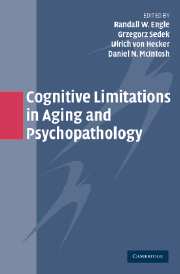Book contents
- Frontmatter
- Contents
- List of Contributors
- Preface
- Acknowledgments
- 1 Cognitive Limitations in Aging and Psychopathology: An Introduction and a Brief Tutorial to Research Methods
- SECTION I WORKING MEMORY AND COGNITIVE FUNCTIONS
- SECTION II AGING AND PSYCHOPATHOLOGY OF COGNITIVE CONTROL
- 5 The Aging of Cognitive Control: Studies of Conflict Processing, Goal Neglect, and Error Monitoring
- 6 Cognitive Control and Schizophrenia: Psychological and Neural Mechanisms
- 7 Aging and Varieties of Cognitive Control: A Review of Meta-Analyses on Resistance to Interference, Coordination, and Task Switching, and an Experimental Exploration of Age-Sensitivity in the Newly Identified Process of Focus Switching
- 8 An Ecological Approach to Studying Aging and Dual-Task Performance
- 9 Cognitive Performance After Preexposure to Uncontrollability and in a Depressive State: Going with a Simpler “Plan B”
- SECTION III ATTENTION, INHIBITION, AND REASONING PROCESSES
- Name Index
- Subject Index
- References
8 - An Ecological Approach to Studying Aging and Dual-Task Performance
Published online by Cambridge University Press: 20 May 2010
- Frontmatter
- Contents
- List of Contributors
- Preface
- Acknowledgments
- 1 Cognitive Limitations in Aging and Psychopathology: An Introduction and a Brief Tutorial to Research Methods
- SECTION I WORKING MEMORY AND COGNITIVE FUNCTIONS
- SECTION II AGING AND PSYCHOPATHOLOGY OF COGNITIVE CONTROL
- 5 The Aging of Cognitive Control: Studies of Conflict Processing, Goal Neglect, and Error Monitoring
- 6 Cognitive Control and Schizophrenia: Psychological and Neural Mechanisms
- 7 Aging and Varieties of Cognitive Control: A Review of Meta-Analyses on Resistance to Interference, Coordination, and Task Switching, and an Experimental Exploration of Age-Sensitivity in the Newly Identified Process of Focus Switching
- 8 An Ecological Approach to Studying Aging and Dual-Task Performance
- 9 Cognitive Performance After Preexposure to Uncontrollability and in a Depressive State: Going with a Simpler “Plan B”
- SECTION III ATTENTION, INHIBITION, AND REASONING PROCESSES
- Name Index
- Subject Index
- References
Summary
“… cognitive aging researchers can accept the reality of declining cognitive powers stemming from the reduced efficiency of the brain but at the same time look for means by which older adults can best hold the negative effects of aging at bay and optimize the mental capacities they possess.”
– Salthouse and Craik (2000, p. 701)A pervasive challenge of modern adult life is to satisfy numerous demands within a constrained period of time. The simultaneous performance of two or more tasks, such as driving and conversing (e.g., Strayer & Johnston, 2001), walking and talking (Kemper, Herman, & Lian, 2003), or listening while note-taking (Tun & Wingfield, 1995), constitutes a cognitive dual-task situation in which attention must be divided. Questionnaire data indicate that older adults rate the difficulty of everyday divided attention activities higher than do younger adults, whereas younger adults report a higher frequency of engaging in dual-task situations compared to older adults (Tun & Wingfield, 1995). The majority of age-comparative studies of divided attention performance concur with the subjective report data (for reviews, see Hartley, 1992; Kramer & Larish, 1996; McDowd, Vercruyssen, & Birren, 1991; McDowd & Shaw, 2000). Since the early 1960s, the importance of dual-task functioning for independent living in old age, coupled with the general trend of age-related declines in such performance, has prompted a steady output of empirical work on this topic (e.g., Broadbent & Heron, 1962).
- Type
- Chapter
- Information
- Cognitive Limitations in Aging and Psychopathology , pp. 190 - 218Publisher: Cambridge University PressPrint publication year: 2005
References
- 31
- Cited by



